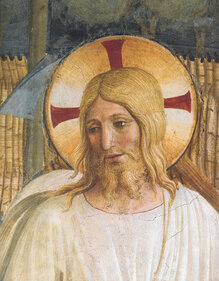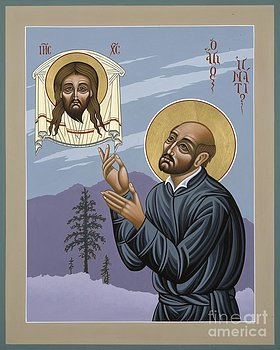 Most of us are familiar with the cartoons in which a character has an angel on one shoulder and a demon on the other, each of which is battling to influence the poor soul. The angel tries to get the character to choose that which is better and the demon uses all sorts of ruses to get the character to do what ‘feels good’ or which seems to suit his or her own needs. The demon tries ardently using all sorts of delightful-looking temptations, persuasions, and charm in an attempt to make something which is not good seem as if it is a good choice. The demon tries everything in its power to get that character to give in. Meanwhile the angel is appealing with what the viewer knows is actually the better choice, the right and just choice, or the healthier choice. We laughed at these cartoons when we were kids, yet there was a lot to learn from them. Those are the tactics of the enemy who will even use charm to get us to stray from the path which leads to God. He will use every ruse he can, hoping that the soul does not realize that the devil’s power is limited vastly in comparison to that of God; he resorts to deception and fear to ensure that the soul is distracted from that reality. This is why it is so important to understand the discernment of spirits: the evil one is plenty smart, and knows how to use distractions and all manner of tactics since he has no other real power: the power he has is the power we give him. And the enemy wants us to forget that God gives us grace which, if utilized, will overcome him every time, even if we have to put up a valiant fight. Therefore, it is essential that we know how the enemy works, and that we know ourselves and our weak points, so that we might be armed with the limitless grace God provides. The best way to do this is through the spiritual discipline which comes from study and prayer.  In his Spiritual Exercises, St. Ignatius of Loyola provides many opportunities for learning spiritual discipline, helping us recognize sin and its effects. In the First Week* of the Exercises, we grapple with sin, our participation in it, and its effects upon us and on the world so that we might learn to recognize it. In the Second Week, we observe the nature of discipleship by spending time with Christ in the gospels so that we learn what Jesus taught. In these first two Weeks we also learn more about ourselves, our patterns, behaviors, and desires. But before we enter into the suffering, death, and resurrection of Jesus, (Weeks 3 and 4), roads upon which we will tread with Him, St. Ignatius provides one of the most important meditations of the entire Exercises, intended to help the retreatant understand the road upon which they are about to embark. To do this, they must learn to discern at a higher level. St. Ignatius understood human nature by reflecting upon his own experience in which he had an initial desire for glory as a follower of Jesus. ** He came to see that whether outwardly or inwardly, (and thus less visible), retreatants might also have some misguided zeal or a glorified view of themselves or of discipleship, a view which could blind them and become an inroad for the enemy to utilize. Ignatius knew how easy it is for a retreatant to be dazzled by the charm of the enemy. Thus, he offered a meditation to help the retreatant learn to recognize the source of their own motivations and therefore to discern what the potential traps might be in their future decision making.  This pivotal meditation provided by St. Ignatius is called The Two Standards. To set the scene Ignatius describes a great battlefield, (almost like a giant football field, metaphorically speaking). On one end is the enemy with his army under his standard (or flag) of allegiance. On the other end of the field is Jesus with His army under His standard. On first glance, it seems to be a ‘no-brainer’ that we would follow Jesus and not Satan. However, it is actually not that simple: Ignatius wants us to see that the enemy is filled with guile and can draw us in before we know it. Therefore, Ignatius guides the retreatant in observing that the temptations of the enemy are quite subtle and exceedingly alluring. He has them imagine Satan, the chief of the enemies, trying to goad and tempt them with riches, honors, pride, etc. That is, all those ways in which they thought they had become indifferent when praying the Principal and Foundation at the beginning of the retreat, are now not so easy to choose. Doing this exercise helps to uncover our true desires and motivations so that we are not led astray even by our best intentions which the evil one wants to twist: it helps us learn how to discern at a deeper level so that we are not swayed by his convincing arguments. But as important as this is, it is not the final goal. The true goal is to conform our heart to that of Jesus so that we might truly become one with Him and with His desires for us and for the world. Only then are we ready to embark on the path to the Cross with Him, so that we might rise with Him as well.  God desires that we have the freedom to choose the good, and to do it for the right reasons. Thus, through this exercise we begin to move toward the true freedom which comes from discovering the purpose for which we were created: to know, serve, and love the Lord, who Ignatius (in understanding the Scriptures) describes as knowing, serving, and loving us first! If we want to grow in holiness, which means we want to become the disciples we were intended to be, we need to stay upon the road which leads us home to God, knowing that while God allows us to choose freely, He definitely has a preference for how we choose; God wants us to spend eternity with Him enjoying His love. In learning to conform our hearts to His, we will also have an effect upon those who we encounter in our daily lives as we move outward in service, motivated by love. It is by our example, by our deeds of love (small or large), that we build the Kingdom and thus, glorify God. And it is in so doing that our response of gratitude is that of true indifference. His will has become ours.  While not everyone can make the Spiritual Exercises, and while some are not called to Ignatian spirituality or are not attracted to it, we can all learn from the lessons taught by St. Ignatius, particularly that of the Two Standards. *** There are many pathways to holiness. No matter which one we are most comfortable with, it is important to know ourselves, our tendencies and desires, and it is important to recognize the pitfalls which the enemy places before us. All followers of Jesus need to grow in intimacy with Him, not only to experience His love, but to learn how to recognize the ways in which He typically acts. Reading the Scriptures and praying with them continually is an effective method for growth in this way. Through Scripture we can see how merciful God has always been, and we can learn through the words and deeds of Jesus how best to be His follower. Jesus is clear that the way of love is not always easy, but that it is His way. And with the help of saints such as Ignatius of Loyola, we can discern the way to proceed, which, while not fool-proof, (as nothing in this life ever is), provides guidelines to avoid moving away from God and helps us respond to Him with love and gratitude. Whatever our present call may be, we must not go ‘into the field’ without spiritual weapons such as the wisdom to discern and the knowledge that God will not abandon us.  We are all called to holiness. Each of us is called to do it in a way unique to our personality, the gifts we are given, and to the circumstances of our lives. Through his life and writings, St. Ignatius offers tools to help us grow in spiritual wisdom and in our intimacy with the Lord. But we also have companions on the journey: we have co-workers in the mission, our brothers and sisters in Christ who accompany us, and we have the Holy Spirit who provides guidance. Finally, we have those who have gone before us, who like St. Ignatius of Loyola, offer the hope that we will not lose our way and who offer valuable insights into how to accomplish the purpose for which we were created.  May we ask the intercession of St. Ignatius of Loyola for assistance in the process of discernment of spirits! May we be inspired by the many Saints and Blesseds who have gone before us and have left legacies of holiness from which to learn! May we pray for vocations to the priesthood and religious life, as well as for the response of holy lay women and men to act as leaders in the faith! May we conform our hearts to the Lord! May we spend time in prayer and study of Scripture so that we may grow in intimacy with God in order to recognize Him more readily! And like St. Ignatius of Loyola, may we put ourselves at the disposal of God so our service might lead to greater love, and our love to greater justice and peace! Let us continue to meet in the heart of Jesus! Peace! ©Michele L. Catanese Notes: Next entry, September 9 * The main body of The Spiritual Exercises of St. Ignatius of Loyola, that is, the retreat, is divided into four parts which he called Weeks. Although the retreat is intended to be 30 days in total, the Weeks are not of equal length, but rather each Week is determined by the pace at which the retreatant is able, guided by the Holy Spirit and discerned by the spiritual director. No two experiences are ever the same, even when the same person makes the Exercises more than once in their lifetime. The retreat can be modified to as few as 8 days or as long as 30 weeks in which one would meet weekly while living in everyday life, (in contrast to the 30 day experience done at a retreat center), depending on the availability or lifestyle of the retreatant. **During the convalescence of St. Ignatius, (as he was in the midst of his conversion experience), he would daydream about doing chivalrous deeds for Jesus or Mary. Sometimes he would imagine he was like St. Francis or St. Dominic doing great things for Christ. But after these daydreams, he noticed he would be restless or agitated; but when he simply imagined putting his life at the disposal of Christ, he found that peace would return. Thus began his experience in understanding discernment of spirits. *** I want to be clear that there are many Christian spiritual approaches to prayer in addition to Ignatian spirituality. Some people are more comfortable with one spiritual tradition rather than another: ‘one size does not fit all’ and so it is important to discern which one is best for you to adopt and practice. A good spiritual director can help with this if you do not know what to look for. Images: 1. My photo, taken in Rome: I took this photo of a painting during a trip to Rome a number of years ago, and unfortunately I cannot remember which of the major basilicas we were in. Nonetheless, I chose it as an example of the heavenly angels battling the fallen angels, now known as demons; in it, those who refused to obey God are being cast out of Heaven. They now occupy themselves serving the 'enemy of human nature,' as St. Ignatius refers to Satan. 2. Painting of St. Ignatius Loyola: This is a rather famous image of the saint. I chose it because it depicts the radiance of his holiness emanating from his face, but also it shows him at prayer. This is a cropped version of a larger painting in which, if memory serves, is of St. Ignatius at prayer as he presides at Eucharist. (He is wearing a chasuble, so that is the clue.) 3. My photo, just outside of Tomintoul, Scotland: This seemed to be a good representation of an open field, reminiscent of the plain or field described by St. Ignatius in The Two Standards meditation. 4. Inset of a painting called Noli me Tangere, by Blessed Fra Angelico: I love the work of Bl. Fra Angelico, so I chose this close-up of the Risen Jesus because Jesus is the goal of our spiritual journey. We desire to conform our heart to His. 5. Icon, St. Ignatius Amidst Alaska, by Fr. William Hart McNichols: I felt like this icon depicted the devotion of St. Ignatius to Jesus. Having Ignatius in a somewhat remote place, such as Alaska, not only highlights the presence of God everywhere, but it seems to be a reminder that spirituality is not contained to one culture. Our church is catholic, that is, universal. You can find this icon and purchase a copy if you so choose at https://fineartamerica.com/featured/st-ignatius-amidst-alaska-141-william-hart-mcnichols.html 6. My photo, hiking in the Highlands of Scotland: This photo seemed appropriate as a reminder that we want to follow the signs, so as not to stray from the path. 7. My photo, fiddleheads, taken while hiking near Granton on Spey, Scotland: These fiddleheads seemed to speak of growth and new life. They certainly stood out from the rest of the grass when I spied them. Those who grow in holiness do stand out even with humility, such as that of these humble plants. NOTE: In compliance with GDPR rules, I wish to make it clear that I do not gather any information on any of my readers at any time.
elise campana
8/26/2019 06:44:26 pm
Comments are closed.
|
Heart Speaks to Heart
|

 RSS Feed
RSS Feed

